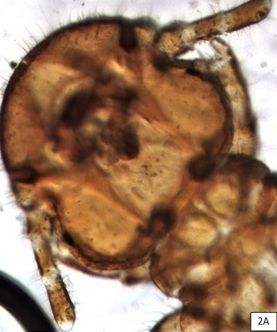First record of Werneckiella equi (Order: Ischnocera) in a horse from the city of Salta, Argentina
DOI:
https://doi.org/10.19137/cienvet202325206Keywords:
Equines, Louse, Pruritus, Salta, Werneckiella equiAbstract
The objective of this work is to report the presence of Werneckiella equi, in a horse from the city of Salta in order to provide information of regional epidemiological relevance and also document the first case of infestation by this parasite in the Northwest of Argentina. A horse of about 8 years old with intense itching and poor body condition, that lived on a property in the urban area of the city of Salta, Argentina, was brought to the consultation. In the particular inspection of the skin, lice were observed, which were collected and sent to the laboratory. Based on the clinical information, further analysis was performed. On the basis of clinical information and parasitological studies, it was determined that the animal was suffering from an infestation of Werneckiella equi. The horse was treated with oral ivermectin, showing improvement and disappearance of the parasites on the skin. What is described in this work is the first report at a regional level and highlights the possibility of occurrence of this presentation in horses that show symptoms of pruritus
Downloads
References
2. Murray MD. Distribución of the eggs of mammalian lice on their hosts. Aust. J. Zool.1957; 5(2):182-187. D
3. Mencke N, Larsen KS, Eydal M, Sigurðsson H. Natural infestation of the chewing lice (Werneckiella equi) on horses and treatment with imidacloprid and phoxim. Parasitol. Res.2004; 94, 367-370. doi: 10.1007/s00436-004-1227-0
4. Larsen KS, Eydal M, Mencke N, Sigurðsson H. Infestation of Werneckiella equi on Icelandic horses, characteristics of predilection sites and lice dermatitis. Parasitol. Res. 2005. 96, 398-401. doi: 10.1007/s00436-005-1380-0
5. Mullen GR, Durden LA. Lice (Phthiraptera). Entomología médica y veterinaria. Prensa académica.2009. pp. 79-41.
6. Lareschi, M. Artrópodos ectoparásitos. En Draggo FB., Macroparásitos: diversidad y ecología La Plata, Argentina: 2017, Edulp. pp.167–183.
7. González A, Del C Castro D, De Villalobos C. Artrópodos de interés médico en Argentina. Fundación Mundo Sano. Serie Enfermedades Transmisibles.2005. Publicación Monográfica. 6, 41-46.
8. Reeves WK, Szumlas DE, Moriarity JR, Loftis AD, Abbassy MM, Helmy IM, et al. Louse- borne bacterial pathogens in lice (Phthiraptera) of rodents and catt le from Egypt. J. Parasitol.2006; 92(2): 313-318. Disponible en: https://phthiraptera.myspecies.info/sites/phthiraptera.info/files/47149.pdf
9. Moreby C. The biting louse genus Werneckiella (Phthiraptera: Trichodectidae) ectoparasitic on the horse family Equidae (Mammalia: Perissodactyla). J. Nat. Hist. 1978; 12(4), 395-412. Disponible en: https://phthiraptera.myspecies.info/sites/phthiraptera.info/files/1063.pdf
10. Wright R. Lice on horses. The Can. Vet. J. 1999; 40(8):590. Disponible en: https://www.ncbi.nlm.nih.gov/pmc/articles/PMC1539778/pdf/canvetj00141-0064.pdf
11. Cicchino AC, Castro del C. Ischnocera. En: Morrone JJ, Coscaron S. Biodiversidad de artrópodos argentinos – Una perspectiva biotaxonómica. 1998 Ediciones Sur. La Plata, Argentina. pp. 124.
12. Price MA, Graham OH. Chewing and sucking lice as parasites of mammals and birds. United States Department of Agriculture, Agriculture Research Service Technical Bulletin. 1997; 1849: 83-84.
13. Egri B. Occurrence and treatment of biting louse (Werneckiella equi equi) infestation in a foal stock in Hungary. Parasitol. Hung.1990; 23: 109-113.
14. Jones CJ, Di Pietro J. Biology and control of arthropod parasites of horses. Comp Cont Ed Pract Vet (USA).1996; 18:551–558
15. Gawler R, Coles GC, Stafford KA. Prevalence and distribution of the horse louse, Werneckiella equi equi, on hides collected at a horse abattoir in. The Vet Record. 2005; 157: 419-420. 16. Da Silva AS, Tonin AA, Lopes LS. Outbreak of lice in horses: epidemiology, diagnosis, and treatment. J. Equine Vet. Sci. 2013; 33(7): 530-532. doi: 10.1016/j.jevs.2012.08.003
17. Romaniuk K, Jaworski Z. Dynamika inwazji Werneckiella equi u zrebiat konika polskiego. Med. Weter. 2008; 11 (64): 1335-1337.
18. Romaniuk K, Jaworski Z. Wpływ sposobu utrzymania oraz wieku koników polskich na przebieg inwazji Werneckiella equi. Med. Weter.2008; 64 (8): 1034-1036. Disponible en : http://www.medycynawet.edu.pl/images/stories/pdf/pdf2008/082008/20080810341036.pdf
19. Al-Quraishy S, Abdel-Ghaffar F, Al-Rasheid KA, Mehlhorn J, Mehlhorn H. Observations on effects of a neem seed extract (MiteStop®) on biting lice (mallophages) and bloodsucking insects parasitizing horses. Parasitol. Res.2012; 110(1): 335-339.
20. Wilson AD. Immune responses to ectoparasites of horses, with a focus on insect bite hypersensitivity. Parasite Immunol.2014; 36(11): 560–572. Disponible en: https://doi.org/10.1111/pim.12142
Contribución de autores
Los autores contribuyeron a la preparación del material, la recopilación y el estudio taxonómico. El primer borrador del manuscrito fue escrito por Mariana Gisela Tolaba Carrillos y todos los autores comentaron las versiones anteriores del manuscrito. Todos los autores leyeron y aprobaron el manuscrito final. Supervisión: Leandro Hipólito Olmos, Griselda Noemi Copa.
Financiamiento
Este trabajo fue realizado mediante fondos provenientes de la Fundación ArgenINTA y del Proyecto de investigación del Consejo de Investigación de la Universidad Nacional Salta (CIUNSa) N° 2740/0.

Downloads
Published
How to Cite
Issue
Section
License
Al momento de enviar sus contribuciones, los colaboradores deberán declarar , de manera fehaciente, que poseen el permiso del archivo o repositorio donde se obtuvieron los documentos que se anexan al trabajo, cualquiera sea su formato (manuscritos inéditos, imágenes, archivos audiovisuales, etc.), permiso que los autoriza a publicarlos y reproducirlos, liberando a la revista y sus editores de toda responsabilidad o reclamo de terceros , los autores deben adherir a la licencia Creative Commons denominada “Atribución - No Comercial CC BY-NC-SA”, mediante la cual el autor permite copiar, reproducir, distribuir, comunicar públicamente la obra y generar obras derivadas, siempre y cuando se cite y reconozca al autor original. No se permite, sin embargo, utilizar la obra con fines comerciales.






4.png)


7.png)



